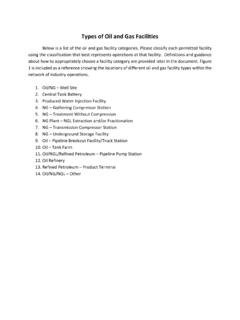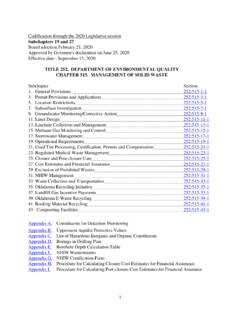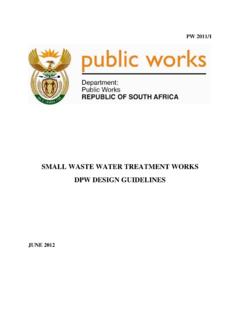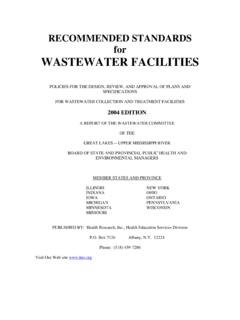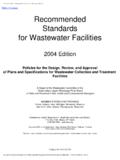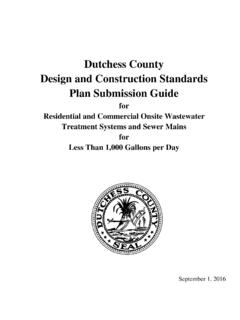Transcription of Codification through the 2021 Legislative session ...
1 1 Codification through the 2021 Legislative session Subchapters 1, 3, 12, 15; Appendix H and N Board adoption - January 12, 2021 Approved by Governor on June 11, 2021 Effective date September 15, 2021 TITLE 252. DEPARTMENT OF ENVIRONMENTAL QUALITY CHAPTER 641. INDIVIDUAL AND small PUBLIC ON-SITE sewage treatment SYSTEMS Subchapter 1. General Provisions .. 252:641-1-1 3. Soil Tests .. 252:641-3-1 5. Building Sewer and Collection Systems .. 252:641-5-1 7. Septic Tanks .. 252:641-7-1 9. Pump Tanks .. 252:641-9-1 10. Aerobic treatment Systems .. 252:641-10-1 11. Subsurface Systems [REVOKED] .. 252:641-11-1 12. Dispersal Fields .. 252:641-12-1 13. Aerobic Systems [REVOKED].. 252:641-13-1 15. Lagoons .. 252:641-15-1 17. Alternative Systems [REVOKED].
2 252:641-17-1 19. [RESERVED] .. 252:641-19-1 21. Certification for On-Site sewage treatment System Installers .. 252:641-21-1 22. Certification for Soil Profilers .. 252:641-22-1 23. Fees .. 252:641-23-1 Appendix A. System Options with Minimum Vertical Separation Distances and Minimum Lot Size Requirements Appendix B. Soil Groups Appendix C. Pipe Specifications for On-Site sewage treatment Systems Appendix D. Sampling Frequency & Testing Requirements for On-Site sewage Application of Treated sewage [REVOKED] Appendix E. Horizontal Separation Distance Requirements for On-Site sewage treatment Systems Appendix F. Estimated Average Daily Flow for small Public On-Site sewage treatment Systems Appendix G. Minimum Trench Length for Subsurface Absorption Systems [REVOKED] Appendix H.
3 Size Charts for On-Site sewage treatment Systems Appendix I Example of the Requirements for a Septic Tank Appendix J. Example of the Requirements for Pump Tank Appendix K. Example Layouts of Conventional Subsurface Absorption Systems, Low Pressure Dosing Systems and ET/A Systems Appendix L. Examples of Retention and Distribution Structures Appendix M. Examples of Trench Installation Appendix N. Examples of Chambers Being Used for Storage and Disposal Appendix O. Examples of Lagoon Installation 2 SUBCHAPTER 1. GENERAL PROVISIONS Section 252:641-1-1. Purpose, authority and applicability 252:641-1-2. Definitions 252 Authorizations and permits for on-site sewage treatment systems 252:641-1-3. General requirements for on-site sewage treatment systems 252:641-1-4.
4 Operation, repairs and maintenance 252:641-1-5. Enforcement 252:641-1-1. Purpose, authority and applicability (a) Purpose. The purpose of this Chapter is to ensure that sewage is properly treated in order to protect the waters of the State, the public health and the environment. This Chapter establishes requirements for the design, construction, installation and operation of individual and small public on-site sewage treatment systems. This Chapter also establishes requirements for persons seeking certification as installers of on-site sewage treatment systems and for persons seeking certification to perform soil profile descriptions to be used to design on-site sewage treatment systems. (b) Authority. This Chapter is authorized by 27A Section(s) 2-2-101, 2-2-201, 2-6-402 and 403; and 59 Section(s) 1158.
5 (c) Applicability. The rules in this Chapter apply to: (1) Any person who owns, designs, constructs, installs, modifies, repairs or operates an on-site sewage treatment system; (2) Any person who seeks certification from the DEQ to install, modify or repair on-site sewage treatment systems; and/or (3) Any person who seeks certification from the DEQ to perform soil profile descriptions to be used to design on-site sewage treatment systems. (d) Disclaimer. The design standards contained in this Chapter are established as minimum criteria and do not guarantee a system's performance. (e) Appendices. All references to appendices are appendices to this Chapter. 252:641-1-2. Definitions In addition to the definitions contained in the Environmental Quality Code (27A Section(s) 2-1-101 et seq.)
6 , the following words, terms and acronyms, when used in this Chapter, shall have the following meaning, unless the context clearly indicates otherwise: "Aerobic treatment unit" means a treatment unit that provides digestion of organic matter through oxidation and has been tested and certified by an ANSI accredited certifier as meeting the most current NSF/ANSI Standard 40, whether or not it includes nitrogen reduction. "Alternative system" means an on-site sewage treatment system that varies from the requirements of on-site sewage treatment systems described in this Chapter. "ANSI" means the American National Standards Institute. "ASTM" means the American Society for Testing and Materials (ASTM International). "Certified installer" means a person in the business of installing or constructing on-site sewage treatment systems who has been certified by the DEQ to inspect and approve his/her own installations.
7 "Certified soil profiler" means a person who has been certified by the DEQ to perform soil profile descriptions to be used to design on-site sewage treatment systems. "Conventional subsurface absorption field" means a gravity-fed subsurface dispersal field, 3 which may be preceded by a lift station, that provides treatment through soil absorption in media-filled trenches. This does not include ET/A or shallow extended dispersal fields. "CSA" means the Canadian Standards Association (CSA Group). "DEQ" means the Department of Environmental Quality. "Designer" means the person who conducts the soil test and/or completes the DEQ Form 641-581P or 641-581SP for submission to the DEQ. "Dispersal site" means the ten-thousand-square-foot (10,000 ft2) rectangular area that contains the test holes used to design the dispersal field.
8 "Distribution structure" means a watertight concrete or plastic compartment, box, or solid piping that allows the distribution of sewage at the same elevation throughout the subsurface treatment field. "Drip irrigation" means the use of pressure to distribute aerobically treated effluent to a subsurface dispersal field using small diameter tubing equipped with pressure compensating emitters. "Evapotranspiration/absorption (ET/A)" means the subsurface dispersal of sewage for treatment through evaporation, transpiration and absorption. "Flow equalization tank" means a storage reservoir that contains an automatically controlled pump that is capable of delivering sewage to an on-site sewage treatment system at a specific hourly rate.
9 "IAPMO" means the International Association of Plumbing and Mechanical Officials. "Individual on-site sewage treatment system" means an on-site sewage treatment system that treats sewage from one individual residence or a duplex with one owner. "Installer" means any person who installs an on-site sewage treatment system or who is in the business of contracting to install or furnishing labor to install on-site sewage treatment systems. "Level" means within a four-inch range of the same elevation. "Lift station" means a short-term storage reservoir, containing an automatically controlled pump, that pumps sewage to a higher elevation for treatment . "Low pressure dosing" means the use of pressure to distribute effluent evenly throughout the dispersal field through small diameter perforated piping.
10 "Major earth fill area" means any area where soil has been added to change the elevation from the original ground level by more than one (1) foot. "Manufactured Media System" means a system containing a dispersal trench product utilizing a non-gravel, fines-free storage media specifically designed for the dispersal and treatment of sewage . "Modification" means the expansion or relocation of any part of an existing on-site sewage treatment system, which does not fall under the definition of new installation. "New installation" means the installation of a new on-site sewage treatment system. This includes the replacement of an existing lagoon, aerobic treatment unit and/or dispersal field, even when the existing septic tank is not replaced.

